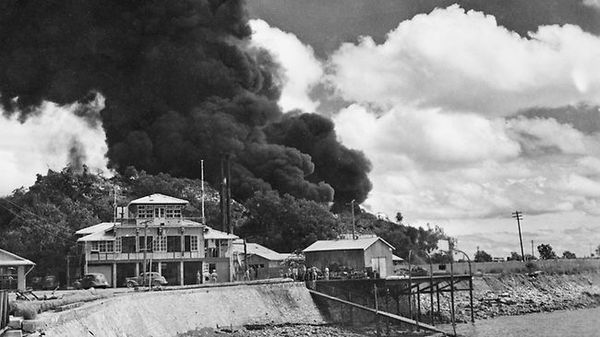This Sunday 19 February is the 75th anniversary of the bombing of Darwin – Warwick’s GRAHAM HUSBAND compiled and contributed the following account of the first time Australia came under direct attack.
On 19 February 1942 mainland Australia came under attack for the first time when Japanese forces mounted two air raids on Darwin. The two attacks, which were planned and led by the commander responsible for the attack on Pearl Harbor 10 weeks earlier, involved 188 attack aircraft which were launched from four Japanese aircraft-carriers in the Timor Sea, and a second raid of 54 land-based bombers. The carrier battle group consisted additionally of two heavy cruisers, one light cruiser, seven destroyers, three submarines, and two other heavy cruisers on distant cover.
In the first attack, which began just before 10am, Kate bombers hit shipping, infrastructure and the town; and Val dive bombers escorted by Zero fighters then attacked shipping in the harbour, and the military and civil aerodromes. The attack ceased after about 25 minutes. The second raid, which began around 11.45am, involved high altitude bombing of the Royal Australian Air Force base by twin-engine machines.
The two raids killed 235 people with a further 300 to 400 wounded. Thirty aircraft were destroyed, including nine out of the ten flying in defence, nine ships in the harbour and two outside were sunk, and some of the civil and military facilities in Darwin were destroyed.
The Japanese lost four aircraft to a spirited defence: two Val bombers and two Zero fighters. One of the fighters crash-landed on Melville Island to Darwin’s north, and its pilot was captured by a local Aboriginal man, to become the first prisoner of war taken on Australian soil.
Contrary to widespread belief at the time, the attacks were not a precursor to an invasion. The Japanese were preparing to invade Timor, and anticipated that a disruptive air attack would hinder Darwin’s potential as a base from which the Allies could launch a counter-offensive, and at the same time would damage Australian morale. The Japanese also planned to take New Guinea, cutting Australia off from US support. Denying Darwin’s ability to act as a base would help achieve that aim.
The air attacks across northern Australia, centring on the Territory, continued until November 1943, by which time the Japanese had raided the Top End over 200 times. The last enemy aircraft was shot down over the Territory in June 1944. During the war other towns in northern Australia were also the target of Japanese air attack, with bombs dropped on Townsville, Katherine, Wyndham, Derby, Broome and Port Hedland.
The response:
In the hours following the air raids of 19 February, believing that an invasion was imminent, some of Darwin’s civilian population began to stream southwards. Approximately half of Darwin’s civilian population ultimately fled. The panic in the town was paralleled by confusion at the RAAF base, where personnel were directed in difficult circumstances to other areas in great numbers. Looting and disorder, and impact of the first raids, subsequently led the government to hurriedly appoint a Commission of Inquiry led by Mr Justice Lowe, which issued two reports, one on 27 March and the other on 9 April 1942.
However, within a few months, Darwin was mounting an even more credible defence, which grew to a co-ordinated response involving fighters, radar, and searchlights. The response grew steadily to involve counterstrike from bombers, largely manned by US forces. Other squadrons involved Dutch and British aircraft joining the Australian effort, and naval units continued to operate against the enemy. By the end of 1942, the tide was beginning to turn and the Japanese started to be pushed back from the lands they had taken in what is now Indonesia and Timor.







